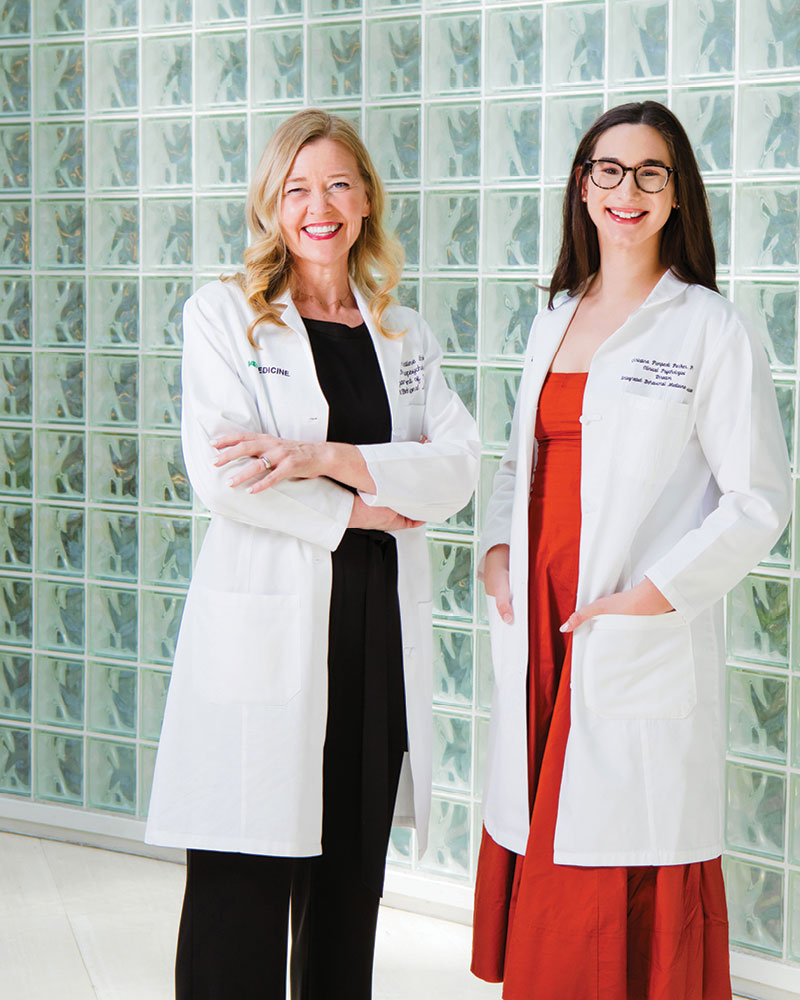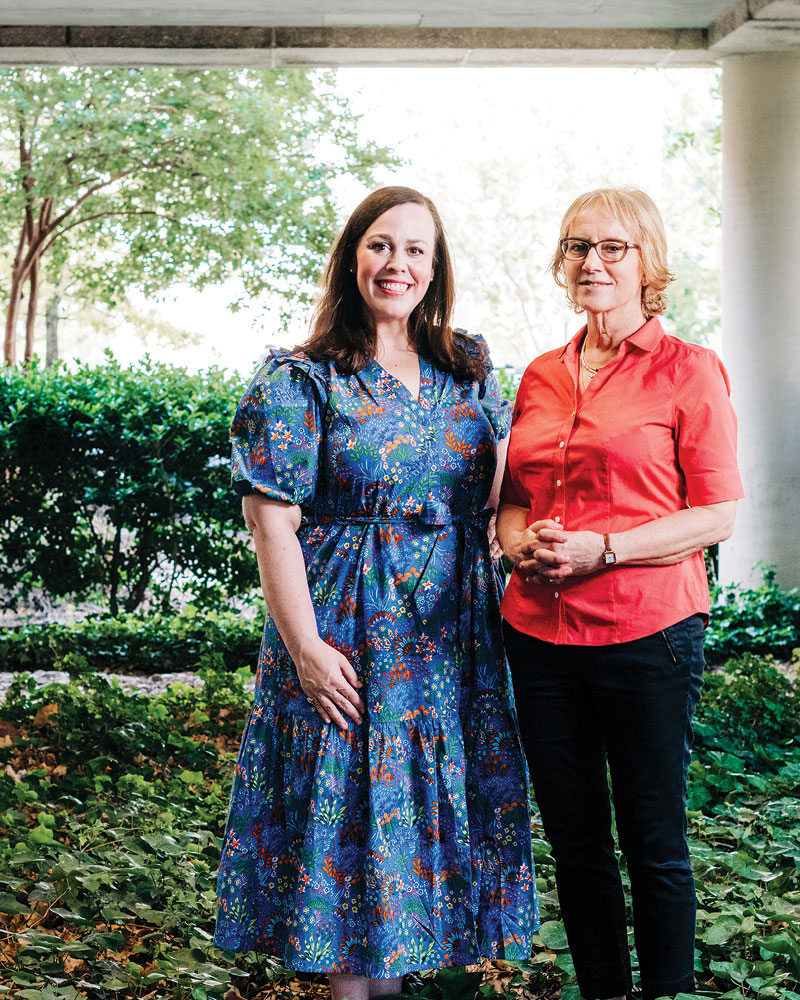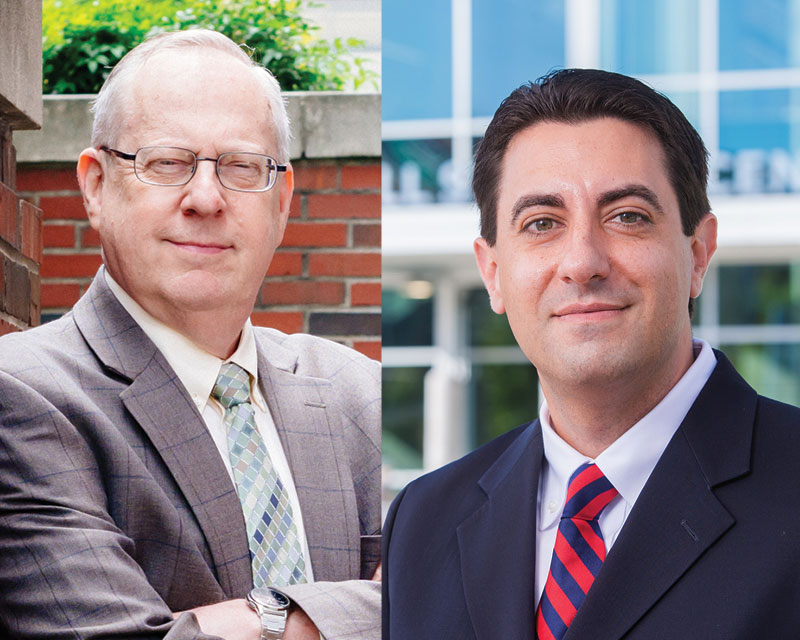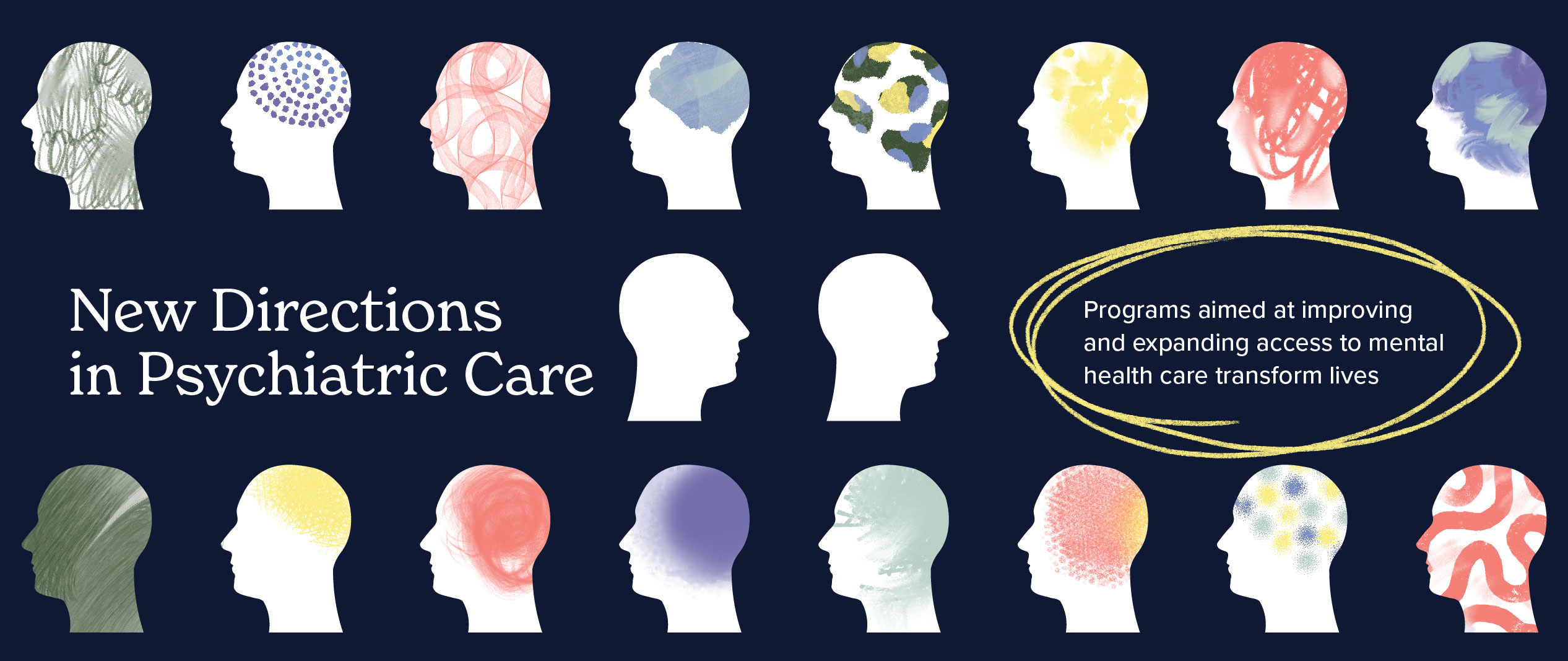As chair of the UAB Department of Psychiatry and Behavioral Neurobiology, Adrienne Lahti, M.D., has a unique perspective on the mental health care landscape in Alabama. “Alabama ranks very low in mental health care,” she said. “In metrics comparing different states’ mental health statistics and access to care, Alabama is usually at 47, 48, 49. The demand is huge.”
Across Alabama, the need for mental health services is often compounded by rural isolation and lack of resources. The Department of Psychiatry and Behavioral Neurobiology is dedicated to bridging that gap, offering a range of innovative programs designed to address the unique challenges faced by the state’s underserved populations. According to Lahti, “The strength of UAB Psychiatry is that it's not only a clinical department, but also one-third of the faculty are researchers, which brings new concepts, new treatments, and new ideas.”
With a compassionate team of experts, cutting-edge research, and a commitment to community, UAB is working to ensure that every individual has access to the support and treatment they deserve. In the following pages, we highlight a few of the department’s programs as well as the providers who are committed to finding innovative ways to get people the treatment they need when they need it the most.

Left to right: Kristine Lokken, Ph.D., and Christina Pierpaoli Parker, Ph.D.,
of the UAB Department of Psychiatry and Behavioral Neurobiology.
Meeting Patients Where They Are
Talk to Christina Pierpaoli Parker, Ph.D., for any length of time and you are struck by her enthusiasm, both for her work as an assistant professor in the Department of Psychiatry and Behavioral Neurobiology and for the growing success of the Integrated Behavioral Medicine Service (iBeMs), the program she proposed and established during her internship in 2020. The service is designed to work directly with primary care physicians to improve referral and follow-through rates of primary care patients in need of behavioral and mental health treatment.
“Primary care has been the de facto mental health system since the 1970s in the United States,” said Parker, who is the program’s director. “Most people with psychological symptoms don’t have access to a psychologist or psychiatrist, or they may have a negative view of mental health care. So, they go see their primary care physician instead. But for many reasons, those patients do not get referred, or if they do, they do not follow through. That’s why integrating behavioral health into the primary care setting just makes sense, because that’s where it’s happening.”
Or more precisely, where it’s not happening. According to data, without a service like iBeMs, primary care physicians recognize less than 50 percent of their patients needing behavioral or mental health care and just 15 percent of those recognized make it through a referral.
When Parker approached her department leadership about starting iBeMs, she found a receptive audience in Kristine Lokken, Ph.D., chief psychologist and professor, and Rachel Fargason, M.D., Patrick Linton Professor, senior associate director of Strategic Planning, and Medical Quality Officer. “Dr. Fargason has always been a champion of integrated medicine but UAB had a few starts and stops with it,” Lokken said. “She was excited to have someone lead the charge.”
Parker put iBeMs into service, embedding it first within two clinics: UAB Medicine Primary and Specialty Care of Gardendale and UAB Nephrology at the Kirklin Clinic. It most recently expanded to the UAB Camellia Medical Group.
During the week, Parker and her associates, a doctoral student and an intern, travel from clinic to clinic consulting with physicians and helping them to identify patients who need care. If behavioral health care is needed, an appointment will be set to see the patient in the familiar environment of their physician’s office. In cases of more immediate symptoms, such as a panic attack or suicidal ideation, an iBeMs team member will travel to the office to see the patient while he or she is there, conduct an assessment, and plan a course of action. If the assessment concludes that medication is advisable, a referral can be made to a psychiatrist. In all cases, the physician receives a comprehensive report on findings and actions to be taken.
The numbers racked up by iBeMs tell a story of success. Data show that when referrals to psychological care are made from primary care, there’s a 75 percent chance that the patient does not follow through. However, with integrated care referrals, the follow-through rate skyrockets to 90 percent.
“We’ve seen that here with Christina,” Lokken said. “In addition to her iBeMs ‘baby,’ she has two actual babies, and while she was on maternity leave, we had a really high no-show rate that recovered when she returned.”
Integrated behavioral care, said Lokken, benefits all areas of care. It gives physicians the confidence to address patients’ issues and reduces provider burnout by referring patients to the appropriate care. It helps patients with their psychological issues and helps them take control of health issues, reducing the patient load for providers. Downstream, integrated care helps reduce emergency department visits by people mistaking psychological issues for physical issues, such as mistaking panic for a heart attack.
With characteristic enthusiasm, Parker shares her vision for iBeMs’ future. “My ultimate goal is to have behavioral medicine integrated into every nook and cranny of the health system, regardless of the clinic. So, if you are struggling with cancer, I want you to be able to see a behavioral health specialist there. If you’re struggling with incontinence, I want you to see a behavioral specialist there. If you are struggling with COPD, with dialysis, with gynecological issues, I want you to be able to see a specialist in each of those clinics.”

Left to right: Leah Pickett, DNP, CRNP, and Rachel Fargason, M.D., lead the UAB Esketamine Clinic.
Esketamine Clinic Transforms Lives
“Serendipity” isn’t a word one might associate with treatment resistant depression (TRD), a type of depression that defies traditional medication. But when describing the development of esketamine as an effective treatment for the disorder, serendipity plays a key role.
“Esketamine is a form of ketamine, a drug that was first used as a sedating or anesthetic agent in horses,” Fargason said. “Ketamine has also been used for decades as a brief surgical anesthetic in human patients. It’s here that we serendipitously discovered its effectiveness in treating TRD.”
Psychiatric patients who struggled with TRD and who had undergone surgery frequently reported feeling much better, Fargason said. Better yet, she added, those with suicidality reported feeling better right away, as opposed to the weeks it can take for other medications to take effect.
Soon, the buzz around ketamine and its effects on TRD triggered a series of international clinical trials. UAB participated in several trials on the S(+)chemical isomer, the stronger of ketamine’s two enantiomers, hence the “esketamine” moniker. Unlike racemic ketamine, which must be given intravenously, this agent can be given intranasally. It wasn’t long before a new word was bandied about: breakthrough.
In 2013, the U.S. Food and Drug Administration (FDA) granted esketamine a “Breakthrough Therapy Designation” to accelerate studies of its effects on TRD, the first antidepressant to receive this designation. Those studies led to the development of the esketamine nasal spray Spravato™, and none too soon.
According to a 2021 study, an estimated 8.9 million Americans experience and are treated for major depressive disorder (MDD). Despite trying multiple traditional antidepressants, 2.9 million of those patients see little improvement and their depression persists.
Esketamine received FDA approval for use in TRD with an accompanying oral antidepressant in 2019, and is FDA approved for use in major depressive disorder with suicide ideation because of its almost immediate effect on suicidality.
“My experience with esketamine is that it opens up a new world of treatment options,” said Fargason, who co-directs the UAB Esketamine Clinic. “The new-age opportunities offered by this agent remind me of when I was a resident and we basically were confined to using the side-effect-ridden tricyclic antidepressants for depression, and then fluoxetine [Prozac] was launched in the U.S. Now, we again have a brand-new medication for patients who’ve been frustrated with years of failed treatment—patients are getting better, getting their lives back, able to work again, able to go back to school, and once again able to participate in and enjoy their family life.”
Esketamine is unique in its mechanism as a non-competitive N-methyl D-aspartate (NMDA) receptor antagonist. Although its mechanism of action is not completely understood, what is known is that the S-molecule increases brain activity of the neurotransmitter glutamate. This increased activity of glutamate increases neuroplasticity—flexibility—of the brain. More flexibility, it seems, enables the brain to manage stress better and helps reverse depression changes.
“It’s really exciting to have this treatment available,” said Leah Pickett, DNP, CRNP, Wellness Manager for Advanced Practice Providers and Esketamine Clinic co-director. Pickett and Fargason worked on the original study that led to the development of Spravato and have served as co-directors of the clinic since its opening in 2020. “We’ve helped a lot of people and that’s very gratifying.”
The UAB Esketamine Clinic recently moved into a larger space, making it more comfortable for patients who must stay for two hours following their dosing. To qualify, a patient must have completed at least two courses of traditional antidepressants, be currently taking an antidepressant they haven’t previously tried, and be referred by their provider.
“A few of our patients have seen effects almost immediately,” Fargason said. “They will come in with a sad or expressionless face and flat affect, and when the treatment is over they are smiling and upbeat. We are able to get most of our patients into remission. About half are able to stop the treatment after the three-month protocol is complete. The other half must come in for maintenance dosing to maintain their remission.
“Often, what we see, though, is that their depression gradually lifts, beyond what a previous medication has been able to do. And that’s what is so exciting—to have a new option to offer. It’s really a joy when you see a patient who’s been so frustrated from years of so many failed trials—sometimes up to 14 failed trials. And here we find that the NMDA antagonist mechanism seems to be the one needed to normalize mood and cognitive functioning to get them back to baseline and being their best self. It’s really exciting.”
Exciting … and serendipitous.
Philanthropy Bolsters Innovation
Depression is the most widespread mood disorder and is often accompanied by shame, guilt, and isolation. In 2022, over 49,000 people in the United States (including over 800 in Alabama) died by suicide, and approximately two-thirds of all suicides are linked to depression.
In Alabama, the burden of depression is particularly heavy. An estimated 157,000 individuals in Jefferson County alone battle depression. The UAB Department of Psychiatry and Behavioral Neurobiology receives a staggering 200 requests for treatment daily.
The UAB Depression and Suicide Center set an ambitious goal in 2017 of raising $10 million to support its mission to increase understanding of and improve treatment for mood disorders. By 2023, this goal was not only met but surpassed, with $10.8 million raised.
As the center’s clinical director, Matthew Macaluso, D.O., has worked collaboratively with other leaders in the Department of Psychiatry and Behavioral Neurobiology to develop clinical programs offering advanced treatments for the most severe forms of depression. These novel clinical programs are directly translated from research conducted by Macaluso and Richard Shelton, M.D., the Charles B. Ireland Professor and center co-director, in collaboration with industry leaders to develop novel mechanism-of-action drugs and devices for severe mood disorders.
The center uses a biopsychosocial patient care approach, crafting personalized treatment plans that can include psychotherapy, intranasal esketamine, vagus nerve stimulation, intravenous ketamine, electroconvulsive therapy, and access to clinical trials of novel therapies. The center will soon add a state-of-the-art repetitive magnetic stimulation treatment device with the MagVenture Atlas Neuro Navigation System. With this addition, UAB will have a cutting-edge program for patients battling depression that rivals what is available anywhere in the world.

Left to right: Richard Shelton, M.D., and Matthew Macaluso, D.O.,
are leaders in the UAB Depression and Suicide Center.
Rev. Gates Shaw, a retired Episcopal pastor, has been a leader in organizing philanthropic support of the center’s fundraising initiative since the center’s inception. “Richard Shelton asked me if I’d chair an advisory board,” Shaw said. ”As I got involved and watched the center gain traction and begin to deliver on its clinical mission, I began to reach out to individuals, foundations, and corporations.”
According to Shaw, while the response he received was mainly positive, he did have to educate some potential supporters. “As with addiction, we sometimes think of depression as a lack of will or a character failure. It's stigmatized, like so many other things, as a personal failure rather than a disease.”
Shaw is quick to share that he has battled depression most of his life and that, as someone who counsels and speaks with people from all walks of life, he is often approached for advice by friends and acquaintances. “I'll be speaking to the board of a foundation and subsequent to that, I'll get a call from one of the board members saying, ‘I'd like to talk to you about my son,’ or ‘I'd like to talk to you about my wife,’ or ‘Can you can you help me understand what is going on?’ So, depression sits right beneath the surface in so many families. And speaking with authority about it means I have to say I know what it is to suffer from depression, and I know what it is to get well,” Shaw said.
Thanks to the outstanding success of the fundraising initiative, as well as a series of impressive grant awards, the center is growing, both in size and impact. “We now have 20 faculty members and literally dozens of research staff and trainees,” Shelton said. “We have delivered a more than five-fold return on investment so far. Since its inception, our center has received more than $55,000,000 in federal grants, industry contracts, and foundation support. Our research programs and clinics will continue to expand into the future.”
A new, $6 million fundraising initiative in the department, the Early Intervention Program, aims to step in early in the course of mental illness, thereby improving the chances of treatment success. “When you look at the onset of mental illness—depression, schizophrenia, substance use disorder—it is in late adolescence/early adulthood,” Lahti said. “So we want to address it at the onset, or as close to the onset as possible. We know that the longer you wait to treat the worse the outcome. In addition to being the chair, I do research on brain imaging and you can see that the longer you wait to treat people, the worse the communication between brain regions, so the brain is losing plasticity.”
The Early Intervention Program fundraising initiative is already over halfway toward its goal, and Lahti is optimistic the goal can be met to get the program off the ground. “I'm totally amazed by the generosity of the community toward our Department of Psychiatry,” she said. “ Their support is incredible. I've never seen that before at other places.”
While the Depression and Suicide Center’s fundraising goal may have been met, Shaw continues to champion the department’s work and the new early intervention initiative. “Ultimately, I want to see people walking around cured. Fortunately, that is also in the heart of the chair of the department, Dr. Lahti, and the center leadership—they, too, want to see people cured.”

